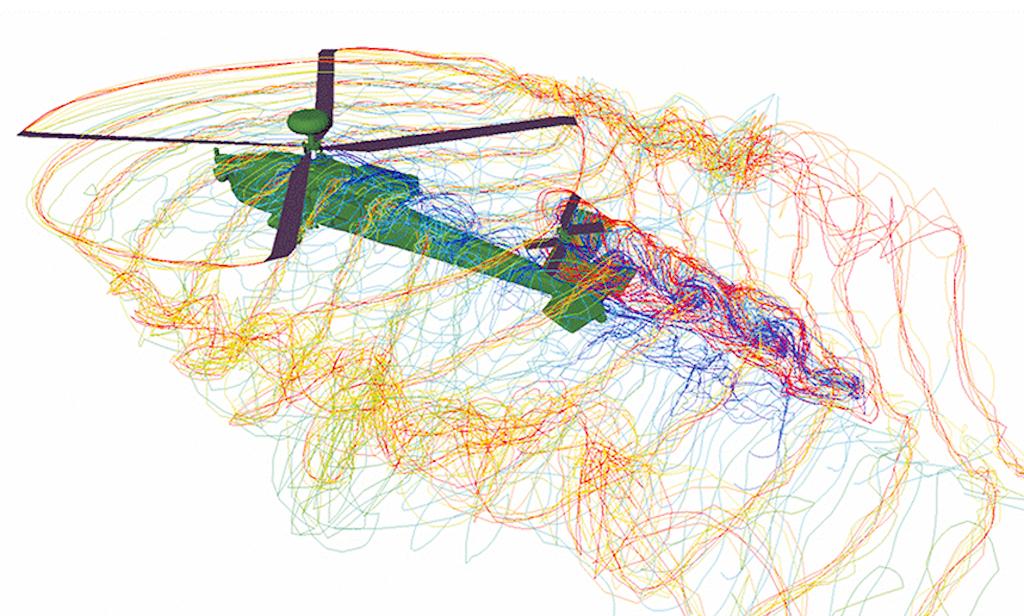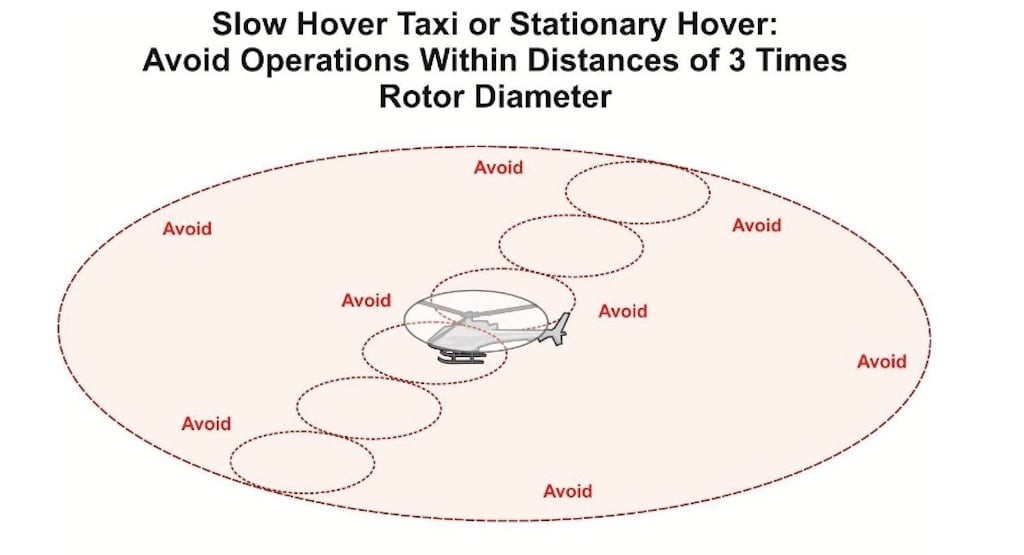
Computational fluid dynamics performed by NASA Ames Research Center illustrates the variation in vortices caused by advancing and retreating rotor blades.
The FAA in the past conducted a comprehensive flight-test program to better understand the risk to a fixed-wing aircraft that inadvertently flies into the wake of a helicopter.
A range of helicopter sizes was used in the testing. Researchers flew an Army National Guard UH-1H, an S-76A belonging to the FAA itself, an Army UH-60 Black Hawk, a Marine Corps Sikorsky CH-53E Super Stallion and an Army Boeing CH-47D Chinook. For fixed-wing aircraft, the agency used a Beechcraft T-34C and a Bellanca 8KCAB Super Decathlon to probe the helicopter wakes. (See: Tymczyszyn, Biehl and Teager, “Flight Test Investigation of the Wake Vortices Generated by Rotorcraft,” in Proceedings of the Aircraft Wake Vortices Conference, Washington, D.C., Oct. 29-31, 1991.)
There are several ways to encounter a vortex, and the FAA test program divided those into parallel and cross-track encounters. A parallel encounter is the most obvious and occurs when the trailing aircraft is flying in roughly the same direction (behind and below) the generating aircraft. A cross-track encounter occurs when you fly through the wake vortex at a large angle. Helicopters tend to fly directly to the ramp, not needing to fly a traffic pattern as fixed-wing aircraft do. Therefore, we’re quite likely to fly cross-track to a helicopter’s path on many occasions, especially nearing the traffic pattern.
The FAA’s test pilots entered the helicopter’s wake vortices during parallel encounters by flying above, below, left and right of the vortex. In general, at small separation distances, the fixed-wing aircraft experienced strong pitch and/or yaw excursions when the helicopter was flying at slower speeds. Close distance encounters resulted in temporary loss of control. Notice that this is a different reaction from wake encounters from airplanes, which predominantly induce a rolling motion.
At larger separation distances, upsets tended to be more pronounced when the helicopter was flying at higher airspeeds. The vortex created by the advancing blade generally generates more abrupt roll and yaw excursions than the retreating blade vortex. During parallel encounters, the trailing aircraft experienced abrupt roll, yaw or pitch excursions.
Weights And Wakes
The UH-60 has a maximum takeoff weight (MTOW) of 20,250 lb. and four rotor blades, with a rotor diameter of just over 53 ft. The T-34C experienced bank angles equal to 45 deg. at distances of a mile behind a UH-60 flying at 70-80 kts. The turbulence was characterized as “hard chops.” The upset bank angles increased to nearly 75- 90 deg. as the separation distance was reduced to a half mile.
The severity of the excursions in the T-34C increased as the UH-60 was slowed to approach speeds. The T-34C was rolled beyond 90 deg. when it flew a mile behind the UH-60. When the T-34C flew a half mile behind the UH-60, it was rolled beyond 180 deg. of bank.
The UH-1 Huey series introduced in the 1960s is still very common as a firefighting and heli-logging aircraft. The UH-1H used for the FAA test had an MTOW of 9,500 lb. and two rotor blades with a 44-ft. diameter. At distances from 0.3 to 0.5 nm, the T-34C experienced rolls between 30 to 75 deg. Several of the test points caused much more pronounced roll excursions and led to loss of control and spins, however.
Readily recognized by its tandem rotor configuration, the Army’s CH-47D Chinook is a heavy-lift helicopter. Its MTOW is 50,000 lb., with a 60-ft. rotor diameter. Predictably, the vortex behind the twin-rotor CH-47D is strong. At distances of less than 0.8 mi., the roll excursions varied from 90 to 210 deg. of bank and many resulted in loss of control and spins.
The Sikorsky CH-53E is even larger than the Chinook. It has an MTOW of 69,750 lb. and a seven-blade main rotor with a 79-ft. diameter. The CH-53E also produced strong roll excursions. At roughly a mile separation, the trailing aircraft was rolled beyond 90 deg. At a half mile, the trailing aircraft was rolled to nearly 180 deg. and also experienced spins.
Several of the flight test runs in the Super Decathlon were abandoned behind the CH-53E when the Decathlon experienced an unexpected shudder in the wings. The vortices of the individual rotor blades created potentially destructive vibrations that led to an immediate cessation of the test point because of concerns about exciting a catastrophic wing flutter mode.
Night-Flying Helicopters

An interesting subset of wake turbulence events in the NASA Aviation Safety Reporting System (ASRS) database involved light aircraft that inadvertently flew into the wake turbulence generated by military helicopters during night operations at joint-use airports.
Night vision goggles allow helicopter pilots to conduct their missions at night. It’s a very unique and highly demanding form of flying that requires specialized equipment, training and proficiency. This necessitates operating without any external lights on the helicopter. ASRS narratives indicated that fixed-wing pilots were not aware of unlit helicopters conducting operations in the dark environment at the airport.
Remember that wake vortices drift with the wind, and helicopters prefer to land and take off facing into the wind. It’s common for a helicopter to land and take off upwind of the landing zone for the runway. A slight crosswind component to the wind can easily blow the helicopter’s vortex toward the runway.
Since the wake vortices from a slow helicopter are strong and create a larger hazard volume, it would behoove us to avoid flying close to slow-flying helicopters. Unfortunately, we will most likely encounter slow flying helicopters when we are flying slow and in the traffic pattern of the airport.
It is wise to avoid the unique risk of helicopter wake vortices. Helicopter wakes deserve caution and a wide berth.
Helicopter Wakes Deserve A Wide Berth, Part 1:
https://aviationweek.com/business-aviation/safety-ops-regulation/helico…





